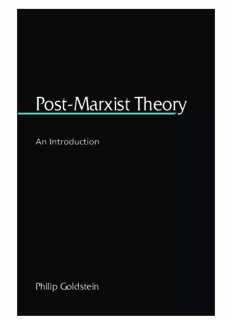
Post-Marxist Theory: An Introduction PDF
Preview Post-Marxist Theory: An Introduction
Post-Marxist Theory An Introduction Philip Goldstein Post-Marxist Theory Post-Marxist Theory An Introduction Philip Goldstein State University of New York Press Published by State University of New York Press, Albany © 2005 State University of New York All rights reserved Printed in the United States of America No part of this book may be reproduced in any manner whatsoever without written permission. No part of this book may be stored in a retrieval system or transmitted in any form or by any means including electronic, electrostatic, magnetic tape, mechanical, photocopying, recording, or otherwise without the prior permission in writing of the publisher. For information, address State University of New York Press, 90 State Street, Suite 700, Albany, NY 12207 Production by Kelli Williams Marketing by Anne M. Valentine Library of Congress Cataloging-in-Publication Data Goldstein, Philip. Post-Marxist theory : an introduction / Philip Goldstein. p. cm. — (SUNY series in postmodern culture) ISBN 0-7914-6301-X (alk. paper) — ISBN 0-7914-6302-8 (pbk. : alk. paper) 1. Communism. 2. Philosophy, Marxist. 3. Marxian economics. I. Title. II. Series. HX73G62 2004 335.4—dc22 2004042983 Contents Acknowledgments vii Introduction: From Marx to Post-Marxism 1 Chapter 1. Economics and Theory: Althusserian Post-Marxism 23 Chapter 2. From Archaeology to Genealogy: Michel Foucault and Post-Marxist Histories 37 Chapter 3. Post-Marxism and Democracy: The Political Theory of Ernesto Laclau and Chantal Mouffe 53 Chapter 4. Sex, Gender, and Philosophy: The Feminist Post-Marxism of Judith Butler 67 Chapter 5. From Althusserian Science to Foucauldian Materialism: The Later Work of Pierre Macherey 81 Chapter 6. Post-Marxism and Cultural Studies: The Reception Theory of Tony Bennett and John Frow 97 Conclusion 109 Notes 115 Works Cited 125 Index 141 v Acknowledgments I am grateful to Joseph Natoli, without whose encourage- ment I may not have put this book together. I am also grate- ful to the University of Delaware for the leave and the University of California at Berkeley for the facilities that en- abled me to write this book. I thank my charming wife Leslie for her close, skeptical questioning of my views, my friends at the Marxist Literary Group for the many chances to present and discuss my work, and the readers and editors of Rethink- ing Marxism, published by the Taylor and Francis Group (http://www.tandf.co.uk/journals/titles/08935696.html) for their helpful comments and responses to my work. Portions of chapter 1 were originally published as “Communism and Postmodern Theory: ARevaluation of Althusser’s Marxism,” Rethinking Marxism, Rethinking Marxism10:3 (Fall 1997), and portions of chapter five were originally published as “Be- tween Althusserian Science and Foucauldian Materialism: The Later Work of Pierre Macherey,” Rethinking Marxism 16:3 (July 2004). Chapter 6 includes highly revised portions of chapter 1 of my Communities of Value (Lexington Press, 2001). An early version of chapter 3 appeared as “Ernesto La- clau and Chantal Mouffe,” in Postmodernism: The Key Fig- ures(Blackwell Publishing, 2002). vii When Gayatri Spivak’s highly intellectual mother read her daughter’s translation of Mr. Derrida . . . , she said, “But dear, how are you going to reconcile your communism with this?” —Interview with Gayatri Spivak, New York Times February 9, 2002 Introduction From Marx to Post-Marxism In 1973 Alice Walker flew to Eatonville, Florida, to plant a tombstone on Zora Neale Hurston’s unmarked grave. Posing as Hurston’s niece, she interviewed the physician, under- taker, and neighbors of Hurston and sought but did not find the grave in the cemetery’s waist-high grass. Afterward, she commissioned a tombstone that declared Zora Neale Hurston “a genius of the South novelist folklorist anthropologist 1901 1960” (“Looking for Zora” 116). Walker says, “We are a people. Apeople do not throw their geniuses away” (“Tale” 69); how- ever, after World War II the work of Hurston, the most pro- lific African American woman writer at that time, was neglected, and Hurston herself forced to accept employment as a maid and welfare support from the state. Moreover, to explain her ensuing oblivion, many critics fault the Marxist realists who, like Richard Wright and Ralph Ellison, consid- ered Hurston a “good darkie” indifferent to social injustice and class conflict. As Mary Helen Washington says, “By the end of the forties, a decade dominated by Wright and the stormy fiction of social realism, the quieter voice of a woman searching for self-realization could not, or would not, be heard” (viii).1 As this critique of Richard Wright and the realists sug- gests, black feminism, which Walker, Toni Morrison, and 1
Description: